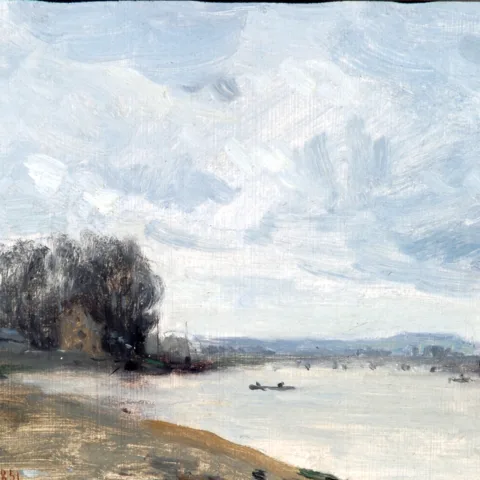The Bowes Museum Blog

Intriguing Finds Observed During the Condition Survey in the Picture Galleries
Whilst cleaning and surveying the paintings on open display in the 2nd floor galleries I was given a rare opportunity to observe the beautiful artworks up close. My eyes were scouting for dirt, cracks and distortions to the structure but I could not help noticing some stunning details and interesting phenomena, therefore I present my intriguing finds in the rest of this blog.
In one painting I could observe pentimenti, which describes deliberate changes in the composition and is carried out by the artist before completion of the painting. As oil paintings age the oil medium and some pigments start to become more transparent than they originally were. This sometimes makes changes more visible over time and after the painting left the artist’s studio the overlaying layers have become transparent. Photo 1 is an example I came across in the picture galleries. The angles of the woman’s legs were shifted at some point during the creative process, and you can see this as a dark outline. One other interesting part of this painting is that it is one of few herringbone canvases in the collection and this makes a striking visual impact whilst observing the painting.

Photo 1: The Rape of the Sabine Women / Castor & Pollux carrying off the daughters of Leucippus (B.M.208) by Giuseppe Porta, also called Giuseppe Salviati. Dark lines painted by the artist in the preparatory layers to indicate the legs of the woman which have become visible as the overlying oil and pigments have become more transparent over time.
Throughout history, frames have been reused and are usually subjected to different fashions and trends as most other artefacts are. Gilded frames were often excessively cleaned in the past causing abrasions and loss to the vulnerable gold leaf. In many cases the bottom bar becomes extensively abraded due to larger amounts of dust and particles being deposited and subsequently cleaned off.
An interesting thing I have seen throughout the surveying process is the reuse of some frames in our collection. One obvious example is a frame that has an abraded bar on the right side and as you can infer, the frame has been re-used and turned 90ᵒ to fit the new painting (Photo 2).

Photo 2: The painting titled The Abbey of Saint-Denis (B.M.525) by Louise-Therese-Aline Gautrin. As seen on the right bar, the abrasion of the gold leaf is more obvious and is an example of a frame that has been reused.
I have seen some really good examples of craftsmanship and beautifully executed detail up close. The horse cover in this Dutch painting has fine detail and tiny brush strokes replicating thread work (photo 3).

Photo 3: A detail of a horse cover in a Dutch painting called The Crucifixion (B.M.174) by the Studio of Jacob Cornelisz van Oostanen.
The painting below shows delicate layering of brush strokes to replicate the lace on clothing (photo 4).

Photo 4: Beautiful painted laces in the painting A Young Spanish Princess (B.M.36) by Bartolome Gonzalez.
I have also had the opportunity to study some of the works by Josephine Bowes. I have enjoyed her use of bold colours and rapid, determined brush strokes to create sunset skies among other things (photo 5).

Photo 5: Josephine Bowes: Landscape with River and Trees: Sunset (J.13).
One way of examining paintings is to direct the light source from one side to produce raking light across the surface. This technique is often used by paintings conservators to enhance the surface topography and reveal any problems to the canvas structure and painting surface. In this case raking light has revealed beautiful impasto brush strokes in a painting by Kinsoen (photo 6).

Photo 6: Detail of lace in raking light from a painting called A German Princess (B.M.305) painted by Francois-Joseph Kinsoen.
Another interesting phenomenon I found in some paintings was metal soaps or metal carboxylate protrusions. These are natural chemical reactions that happen between the oil medium and some pigments on paintings when they age. The metal soaps can also undergo a volumetric change and bulge out from the surface, as seen in photo 7. Metal soaps have the recent years become quite a hot topic for painting conservators and conservation scientists, and research into this area has broadened our understanding of how paintings age and change.

Photo 7: Metal soaps found in the painting called St Paul (B.M.68) by Fransesco Fracanzano.
Paintings slowly degrade, become brittle and cracks will eventually appear on the surface. The survey has enabled us to prioritize which paintings might need remedial conservation in the future and is a way for to make informed decisions about care of the collection. The process of dusting and surveying 366 paintings was a long process, but I am happy to conclude that most of the paintings on display are in excellent condition. It has been a privilege to be so close to such extraordinary artworks.
By Tor Skaaland, Paintings Conservation ICON Intern







